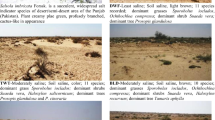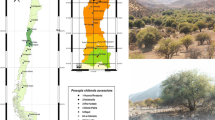Abstract
Serpentine soils are hostile to plant life. They are dry, contain high concentrations of nickel and have an unfavorable calcium/magnesium ratio. The dioecious plant Silene dioica (L.) Clairv. (Caryophyllaceae) is the most common herb on serpentine soils in the Swedish mountains. It also commonly grows on non-serpentine soils in the subalpine and coastal area. I have compared the germination frequency, plant establishment and growth of serpentine and subalpine non-serpentine populations in serpentine soil under greenhouse conditions. Further more I have studied the specific effect of nickel on root and shoot growth of serpentine and non-serpentine plants from the subalpine and coastal area in solutions with different concentrations of nickel. Plants from serpentine and non-serpentine populations grew well and in a similar fashion in serpentine soil. Moreover, S. dioica plants, irrespective of original habitat, tolerated enhanced concentrations of nickel when grown in solutions. An analysis of metal content in serpentine plants from natural populations shows that S. dioica has a higher nickel concentration in the roots than in the shoots. The growth studies show that S. dioica is constitutively adapted to serpentine, and that all populations have the genetic and ecological tolerance to grow on serpentine.
Similar content being viewed by others
References
Antonovics J and Bradshaw A D 1970 Evolution in closely adjacent populations. VIII. Clinal patterns at a mine boundary. Heredity 25, 349–362.
Antonovics J, Bradshaw A D and Turner R G 1971 Heavy metal tolerance in plants. Adv. Ecol. Res. 7, 1–85.
Baker A J M 1981 Accumulators and excluders-strategies in the response of plants to heavy metals. J. Plant. Nutr. 3, 643–654.
Baker A J M and Brooks R R 1989 Terrestrial higher plants which hyperaccumulate metallic elements — a review of their distribution, ecology and phytochemistry. Biorecovery 1, 81–126.
Baker A J M, Brooks R R, Pease A J and Malaisse F 1983 Studies on copper and cobalt tolerance in three closely related taxa within the genus Silene L. (Caryophyllaceae) from Zaire. Plant and Soil 73, 377–385.
Baker A J M and Walker P L 1990 Ecophysiology of metal uptake by tolerant plants. In Heavy Metal Tolerance in Plants. Eds. A JShaw. pp 155–177. CRC Press, Florida, USA.
Bradshaw A D, McNeilly T and Gregory R P G 1965 Industrialization, evolution and the development of heavy metal tolerance in plants. Br. Ecol. Soc. Symp. 5, 327–343.
Brooks R R 1987 Serpentine and Its Vegetation. Croom Helm Ltd, Beckenham, UK. 454 p.
Brooks R R, Lee J, Reeves R D and jaffré T 1977 Detection of nickeliferious rocks by analysis of herbarium specimens of indicator plants. J. Geochem. Explor. 7, 49–77.
Carlson E W 1974 The Plant Root and Its Environment. University Press of Virginia, Charlottesville, USA.
DeVos C H R, Vonk M J, Vooijs R and Schat H 1992 Glutathione depletion due to copper-induced phytochelatin synthesis causes oxidative stress in Silene cucubalus. Plant Physol. 98, 853–858.
Ernst W 1974 Schwermetallvegetation der Erde. Gustav Fischer Verlag, Stuttgart, Germany. 194 p.
Ernst W 1976 Physiological and biochemical aspects of metal tolerance. In Effects of Air Pollutants in Plants. Ed. T AMansfield. pp 115–133. Cambridge University Press, London, UK.
Gabbrielli R, Pandolfini T, Vergnano O and Palandri M R 1990 Comparison of two serpentine species with different nickel tolerance strategies. Plant and Soil 122, 271–277.
Gregory R P G and Bradshaw A D 1965 Heavy metal tolerance in populations of Agrostis tenuis Sibth. and other grasses. New Phytol. 64, 131–143.
Hickey D A and McNeilly T 1975 Competition between metal tolerant and normal plant populations. A field experiment on normal soil. Evolution 29, 458–464.
Homer F A, Reeves R D, Brooks R R and Baker A J M 1991 Characterization of the nickel-rich extract from the nickel hyperaccumulator Dichapetalum gelonioides. Phytochemistry 30, 2141–2145.
Huss-Danell K 1978 Nitrogenase activity measurements in intact plants of Alnus incana. Physiol. Plant. 43, 372–376.
Jain S K and Bradshaw A D 1966 Evolutionary divergence among adjacent plant populations. I. The evidence and its theoretical analysis. Heredity 21, 407–441.
Johnston W R and Proctor J 1981 Growth of serpentine and nonserpentine races of Festuca rubra in solutions simulating the chemical conditions in a toxic serpentine soil. J. Ecol. 69, 855–869.
Jonsell B 1994 Silene dioica L. In Flora Nordica, Vol. 1. Ed. BJonsell. Bergianska Stiftelsen, Stockholm, Sweden. (In prep).
Jowett D 1964 Population studies on lead tolerant Agrostis tenuis. Evolution 18, 70–80.
Kersten W J, Brooks R R, Reeves R D and Jaffré T 1980 Nature of nickel complexes in Psychotria douarrei and other nickelaccumulating plants. Phytochemistry 19, 1963–1965.
Kruckeberg A R 1984 California Serpentines: Flora, Vegetation, Geology, Soils and Management Problems. University of California Press, Los Angeles, USA. 180 p.
Lindsay W L and Norvell W A 1978 Development of a DTPA soil test for zinc, iron manganese, and copper. Soil Sci. Soc. Am. J. 42, 421–428.
Lolkema P C, Donker M H, Schouten A J and Ernst W H O 1984 The possible role of metallothioneins in copper tolerance of Silene cucubalus. Planta 162, 174–179.
Macnair M R 1981 Tolerance of higher plants to toxic materials. In Genetic Consequences of Man-made Change. Eds. J MBishop and L MCock. pp 177–199. Academic Press, London, UK.
Macnair M R 1983 The genetic control of copper tolerance in the yellow monkey flower, Mimulus guttatus. Heredity 50, 283–293.
McNaughton S J, Folsom T C, Lee T, Park F, Price C, Roeder D, Schmitz J and Stockwell C 1974 Heavy metal tolerance in Typha latifolia without the evolution of tolerant races. Ecology 55, 1163–1165.
McNeilly T and Bradshaw A D 1968 Evolutionary processes in populations of copper tolerant Agrostis tenuis Sibth. Evolution 22, 108–118.
Prát S 1934 Die Erblichkeit der Resistenz gegen Kupfer. Ber. Dt. Bot. Ges. 52, 65–67.
Proctor J 1971 The plant ecology of serpentine. III. The influence of a high magnesium/calcium ratio and high nickel and chromium levels in some British and Swedish serpentine soils. J. Ecol. 59, 827–842.
Reeves R D and Brooks R R 1983 European species of Thlaspi L. (Cruciferae) as indicators of nickel and zinc. J. Geochem. Explor. 18, 275–283.
Robertson A I and Meakin M E R 1980 The effect of nickel on cell division and growth of Brachystegia spiciformis seedlings. Kirkia 12, 115–125.
Rune O 1953 Plant life on serpentines and related rocks in the north of Sweden. Acta Phytogeogr. Suecica 31, 1–139.
Rune O and Westerbergh A 1992 Phytogeographic aspects of the serpentine flora of Scandinavia. In The Vegetation of Ultramafic (Serpentine) Soils. Eds. A J MBaker, JProctor and R DReeves. pp 451–459. Intercept Ltd, Andover, UK.
Salisbury F B and Ross C W 1985 Plant Physiology. 3rd Edition. Wadsworth Publishing Company, Belmont, California, USA. 540 p.
Sasse F 1979 Untersuchungen an Serpentinstandorten in Frankreich, Italien, Österreich und der Bundesrepublik Deutschland. II. Pflanzenanalysen. Flora 168, 578–594.
Schat H and TenBookum W M 1992 Metal-specificity of metal tolerance syndromes in higher plants. In The Vegetation of Ultramafic (Serpentine) Soils. Eds. A J MBaker, JProctor and R DReeves. pp 337–352. Intercept Ltd, Andover, UK.
Schat H, Kupier E, TenBookum W M and Vooijs R 1993 A general model for the genetic control of copper tolerance in Silene vulgaris: evidence from crosses between plants from different tolerant populations. Heredity 70, 142–147.
Vergnano Gambi O, Gabbrielli R and Pancaro L 1982 Nickel, chromium and cobalt in plants from Italian serpentine areas. Acta Oecologia Oecol. Plant. 3, 291–306.
Verkleij J A C, Koevoets P, van'tRiet J, vanRossenberg M C, Bank R and Ernst W H O 1989 The role of metal-binding compounds in the copper tolerance mechanism of Silene cucubalus. In Metal Ion Homeostasis: Molecular Biology and Chemistry. Eds. D HHamer and D RWinge. pp 347–357. Alan R. Liss, New York, USA.
Verkleij J A C and Schat H 1990 Mechanisms of metal tolerance in higher plants. In Heavy Metal Tolerance in Plants. Eds. A JShaw. pp 179–193. CRC Press, Florida, USA.
Westerbergh A and Saura A 1992 The effect of serpentine on the population structure of Silene dioica (Caryophyllaceae). Evolution 46, 1537–1548.
Wilkins D A 1957 A technique for the measurement of lead tolerance in plants. Nature 180, 37–38.
Woolhouse H W 1983 Toxicity and tolerance in the responses of plants to metals. In Encyclopedia of Plant Physiology. New Series. Eds. O LLange, P SNobel, C BOsmond and HZiegler. Vol 12 C, pp 245–300. Springer-Verlag, Berlin, Germany.
Author information
Authors and Affiliations
Rights and permissions
About this article
Cite this article
Westerbergh, A. Serpentine and non-serpentine Silene dioica plants do not differ in nickel tolerance. Plant Soil 167, 297–303 (1994). https://doi.org/10.1007/BF00007956
Received:
Accepted:
Issue Date:
DOI: https://doi.org/10.1007/BF00007956




